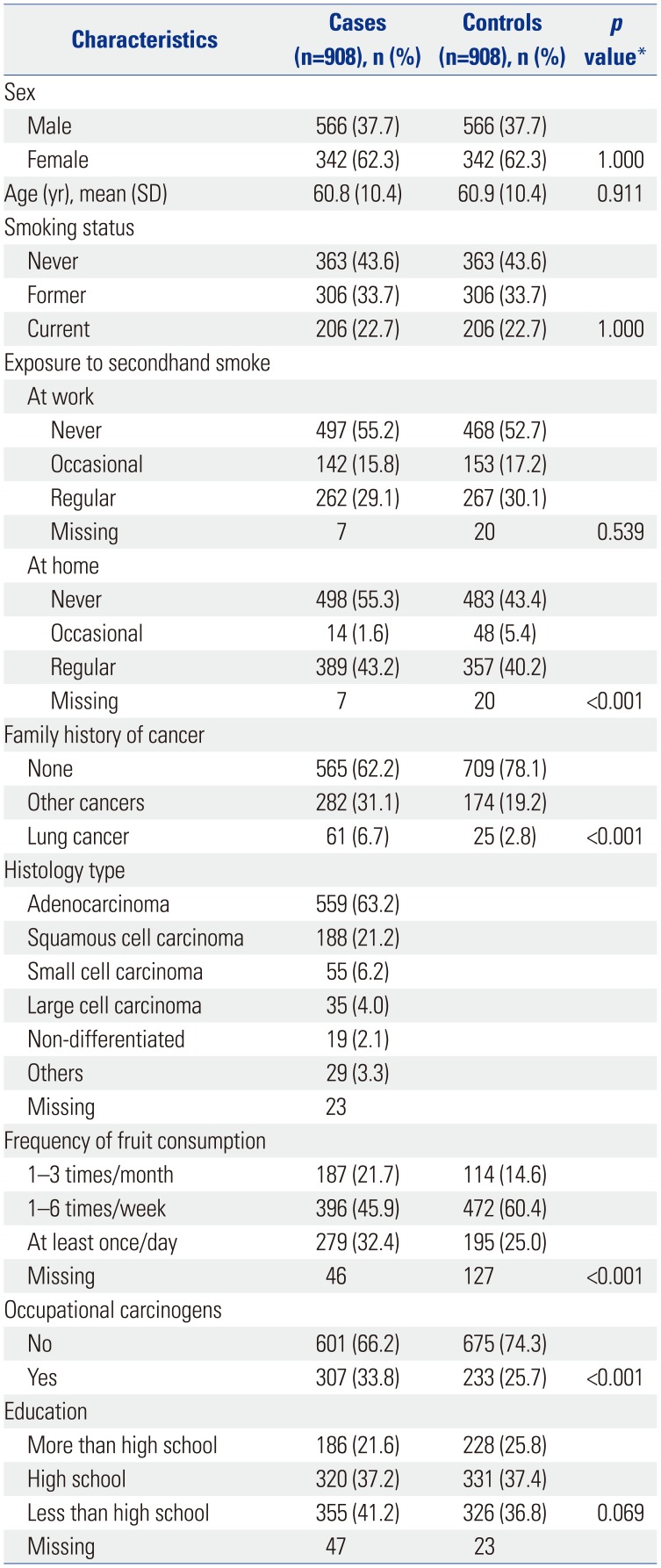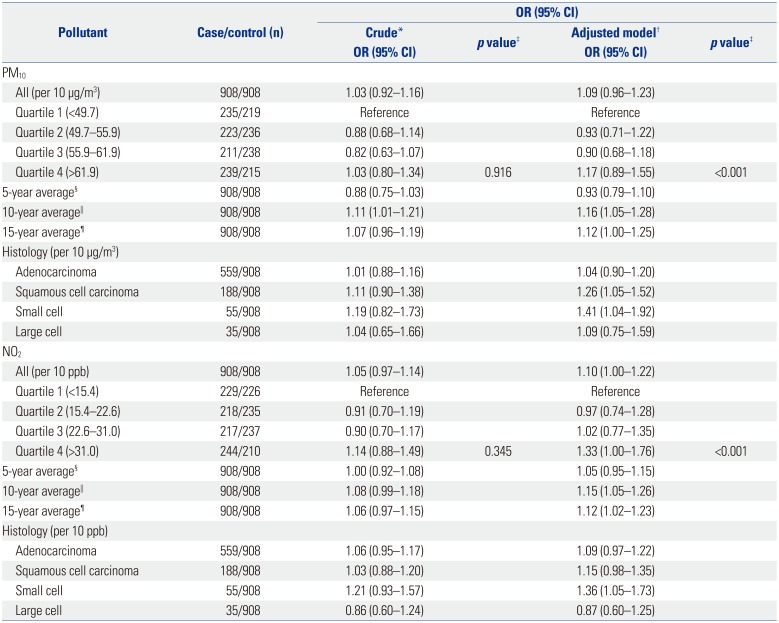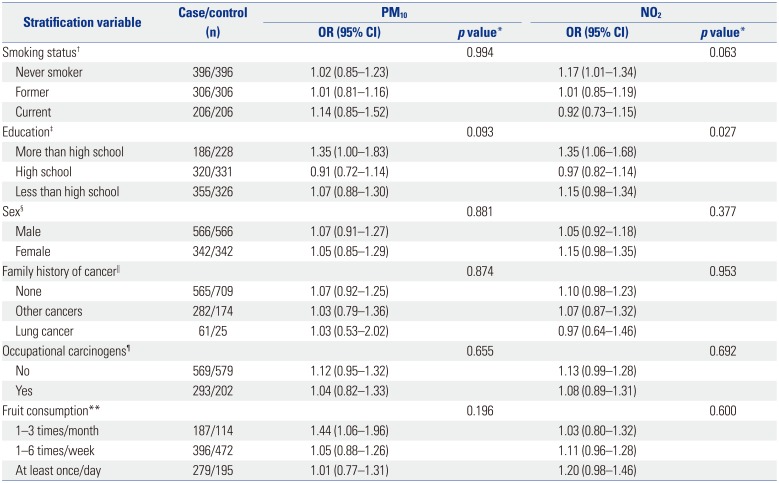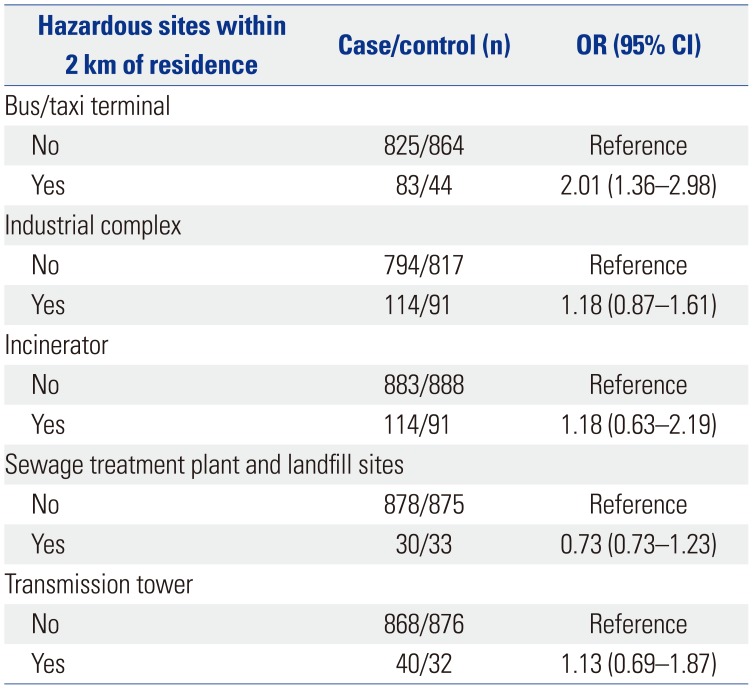1. Park JY, Jang SH. Epidemiology of lung cancer in Korea: recent trends. Tuberc Respir Dis (Seoul). 2016; 79:58–69. PMID:
27064578.

2. In KH, Kwon YS, Oh IJ, Kim KS, Jung MH, Lee KH, et al. Lung cancer patients who are asymptomatic at diagnosis show favorable prognosis: a Korean Lung Cancer Registry Study. Lung Cancer. 2009; 64:232–237. PMID:
18809225.

3. Gabrielson E. Worldwide trends in lung cancer pathology. Respirology. 2006; 11:533–538. PMID:
16916324.

4. Chen F, Cole P, Bina WF. Time trend and geographic patterns of lung adenocarcinoma in the United States, 1973-2002. Cancer Epidemiol Biomarkers Prev. 2007; 16:2724–2729. PMID:
18086779.

5. Chen F, Jackson H, Bina WF. Lung adenocarcinoma incidence rates and their relation to motor vehicle density. Cancer Epidemiol Biomarkers Prev. 2009; 18:760–764. PMID:
19273483.

6. Liaw YP, Ting TF, Ho CC, Chiou ZY. Cell type specificity of lung cancer associated with nitric oxide. Sci Total Environ. 2010; 408:4931–4934. PMID:
20708215.

7. Hystad P, Demers PA, Johnson KC, Carpiano RM, Brauer M. Long-term residential exposure to air pollution and lung cancer risk. Epidemiology. 2013; 24:762–772. PMID:
23676262.

8. Ezzati M, Lopez AD. Measuring the accumulated hazards of smoking: global and regional estimates for 2000. Tob Control. 2003; 12:79–85. PMID:
12612368.

9. Beelen R, Hoek G, van den Brandt PA, Goldbohm RA, Fischer P, Schouten LJ, et al. Long-term exposure to traffic-related air pollution and lung cancer risk. Epidemiology. 2008; 19:702–710. PMID:
18633326.

10. Raaschou-Nielsen O, Bak H, Sørensen M, Jensen SS, Ketzel M, Hvidberg M, et al. Air pollution from traffic and risk for lung cancer in three Danish cohorts. Cancer Epidemiol Biomarkers Prev. 2010; 19:1284–1291. PMID:
20447920.

11. Spitz MR, Wu X, Wilkinson A, Wei Q. Cancer of the lung. In : Schottenfeld D, Fraumeni JF, editors. Cancer Epidemiology and Prevention. Oxford: Oxford University Press;2006. p. 638–658.
12. Nyberg F, Gustavsson P, Järup L, Bellander T, Berglind N, Jakobsson R, et al. Urban air pollution and lung cancer in Stockholm. Epidemiology. 2000; 11:487–495. PMID:
10955399.

13. Pope CA 3rd, Burnett RT, Thun MJ, Calle EE, Krewski D, Ito K, et al. Lung cancer, cardiopulmonary mortality, and long-term exposure to fine particulate air pollution. JAMA. 2002; 287:1132–1141. PMID:
11879110.

14. Beeson WL, Abbey DE, Knutsen SF. Long-term concentrations of ambient air pollutants and incident lung cancer in California adults: results from the AHSMOG study. Adventist Health Study on smog. Environ Health Perspect. 1998; 106:813–822.
15. Raaschou-Nielsen O, Andersen ZJ, Beelen R, Samoli E, Stafoggia M, Weinmayr G, et al. Air pollution and lung cancer incidence in 17 European cohorts: prospective analyses from the European Study of Cohorts for Air Pollution Effects (ESCAPE). Lancet Oncol. 2013; 14:813–822. PMID:
23849838.
16. Puett RC, Hart JE, Yanosky JD, Spiegelman D, Wang M, Fisher JA, et al. Particulate matter air pollution exposure, distance to road, and incident lung cancer in the nurses' health study cohort. Environ Health Perspect. 2014; 122:926–932. PMID:
24911062.

17. Raaschou-Nielsen O, Andersen ZJ, Hvidberg M, Jensen SS, Ketzel M, Sørensen M, et al. Lung cancer incidence and long-term exposure to air pollution from traffic. Environ Health Perspect. 2011; 119:860–865. PMID:
21227886.

18. Chen G, Wan X, Yang G, Zou X. Traffic-related air pollution and lung cancer: a meta-analysis. Thorac Cancer. 2015; 6:307–318. PMID:
26273377.

19. López-Cima MF, García-Pérez J, Pérez-Gómez B, Aragonés N, López-Abente G, Tardón A, et al. Lung cancer risk and pollution in an industrial region of Northern Spain: a hospital-based case-control study. Int J Health Geogr. 2011; 10:10. PMID:
21266041.

20. Xu ZY, Blot WJ, Xiao HP, Wu A, Feng YP, Stone BJ, et al. Smoking, air pollution, and the high rates of lung cancer in Shenyang, China. J Natl Cancer Inst. 1989; 81:1800–1806. PMID:
2555531.

21. Kim CH, Lee YC, Hung RJ, McNallan SR, Cote ML, Lim WY, et al. Exposure to secondhand tobacco smoke and lung cancer by histological type: a pooled analysis of the International Lung Cancer Consortium (ILCCO). Int J Cancer. 2014; 135:1918–1930. PMID:
24615328.

22. Whitwell F, Newhouse ML, Bennett DR. A study of the histological cell types of lung cancer in workers suffering from asbestosis in the United Kingdom. Br J Ind Med. 1974; 31:298–303. PMID:
4371804.

23. Yorifuji T, Kashima S, Tsuda T, Ishikawa-Takata K, Ohta T, Tsuruta K, et al. Long-term exposure to traffic-related air pollution and the risk of death from hemorrhagic stroke and lung cancer in Shizuoka, Japan. Sci Total Environ. 2013; 443:397–402. PMID:
23208275.

24. Guo Y, Zeng H, Zheng R, Li S, Barnett AG, Zhang S, et al. The association between lung cancer incidence and ambient air pollution in China: a spatiotemporal analysis. Environ Res. 2016; 144(Pt A):60–65. PMID:
26562043.

25. Lee JY, Leem JH, Kim HC, Hwang SS, Jung DY, Park MS, et al. Land use regression model for assessing exposure and impacts of air pollutants in school children. J Korean Soc Atmos Environ. 2012; 28:571–580.

26. Chen JJ, Ho SY, Au WM, Wang MP, Lam TH. Family smoking, exposure to secondhand smoke at home and family unhappiness in children. Int J Environ Res Public Health. 2015; 12:14557–14570. PMID:
26580642.

27. Leem JH, Kim HC, Ryu JS, Won JU, Moon JD, Kim YC, et al. Occupational lung cancer surveillance in South Korea, 2006-2009. Saf Health Work. 2010; 1:134–139. PMID:
22953173.

28. StataCorp. Stata Multiple-Imputation Reference Manual: Release 13. College Station, TX: Stata Press;2013.
29. Seaman SR, Keogh RH. Handling missing data in matched case-control studies using multiple imputation. Biometrics. 2015; 71:1150–1159. PMID:
26237003.

30. Heinrich J, Thiering E, Rzehak P, Krämer U, Hochadel M, Rauchfuss KM, et al. Long-term exposure to NO2 and PM10 and all-cause and cause-specific mortality in a prospective cohort of women. Occup Environ Med. 2013; 70:179–186. PMID:
23220504.
31. Samet JM, Avila-Tang E, Boffetta P, Hannan LM, Olivo-Marston S, Thun MJ, et al. Lung cancer in never smokers: clinical epidemiology and environmental risk factors. Clin Cancer Res. 2009; 15:5626–5645. PMID:
19755391.

32. Nafstad P, Håheim LL, Oftedal B, Gram F, Holme I, Hjermann I, et al. Lung cancer and air pollution: a 27 year follow up of 16 209 Norwegian men. Thorax. 2003; 58:1071–1076. PMID:
14645978.

33. Ou CQ, Hedley AJ, Chung RY, Thach TQ, Chau YK, Chan KP, et al. Socioeconomic disparities in air pollution-associated mortality. Environ Res. 2008; 107:237–244. PMID:
18396271.

34. Samet JM, Dominici F, Curriero FC, Coursac I, Zeger SL. Fine particulate air pollution and mortality in 20 U.S. cities, 1987-1994. N Engl J Med. 2000; 343:1742–1749. PMID:
11114312.

35. Gouveia N, Fletcher T. Time series analysis of air pollution and mortality: effects by cause, age and socioeconomic status. J Epidemiol Community Health. 2000; 54:750–755. PMID:
10990478.

36. Linseisen J, Rohrmann S, Miller AB, Bueno-de-Mesquita HB, Büchner FL, Vineis P, et al. Fruit and vegetable consumption and lung cancer risk: updated information from the European Prospective Investigation into Cancer and Nutrition (EPIC). Int J Cancer. 2007; 121:1103–1114. PMID:
17487840.
37. Kelly FJ. Dietary antioxidants and environmental stress. Proc Nutr Soc. 2004; 63:579–585. PMID:
15831130.

38. Cesaroni G, Porta D, Badaloni C, Stafoggia M, Eeftens M, Meliefste K, et al. Nitrogen dioxide levels estimated from land use regression models several years apart and association with mortality in a large cohort study. Environ Health. 2012; 11:48. PMID:
22808928.










 PDF
PDF ePub
ePub Citation
Citation Print
Print


 XML Download
XML Download